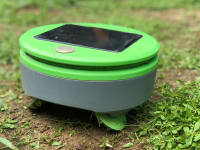 Credit:
Getty Images / mdphoto16
Credit:
Getty Images / mdphoto16
Products are chosen independently by our editors. Purchases made through our links may earn us a commission.
Everyone loves to spend time outside as the weather gets nicer, but not everyone wants to spend all day maintaining their yard. Here are tips to help you save time on lawn and garden tasks this spring, so you can spend more time enjoying your outdoor space.
1. Mow less
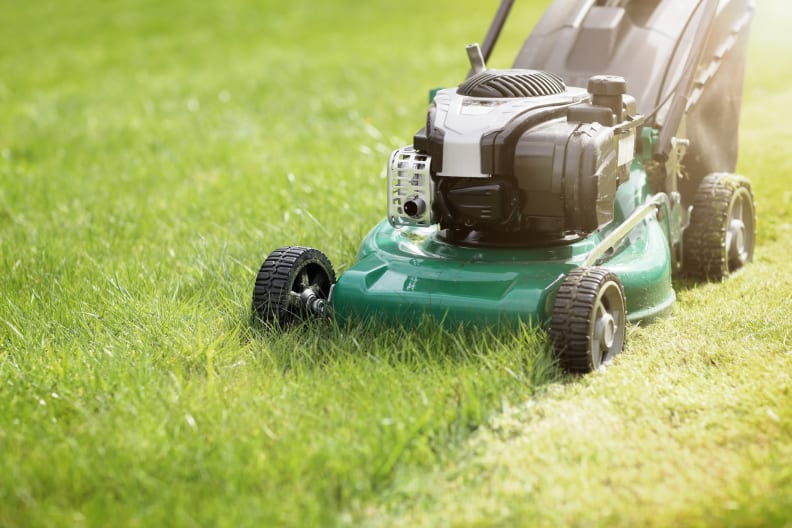
Cutting your grass too low can deprive it of the sunlight and water it needs to thrive.
Your parents may have kept the grass trimmed to a bare inch above the ground, but nowadays, landscape experts recommend that you don’t cut don’t cut grass until it reaches 2.5 to 3.75 inches tall, and that you remove only one-third of the grass blade at each mowing—so a 4.5-inch blade shouldn’t be mowed any shorter than 3 inches. Relax and let your grass grow a little. Your lawn will thank you.
2. Automate your watering
Plants don’t like to rush. They’ll get more moisture from a long, slow, gentle rain than a sudden downpour, when most of the water runs off your yard into a storm drain.
It takes a while to get water all the way down to your plants’ roots, which are at least 3 to 4 inches down for lawns and many flowers and vegetables. Instead of standing outside holding a hose for hours this summer, get a smart hose timer or a smart sprinkler that you can manage from your phone or via a compatible smart speaker. You’ll save time all summer, and have healthier plants.
Lawns and vegetable gardens need an inch of rain weekly. Use a rain gauge to see if you’re getting the water your plants need, or walk across your lawn and look at your footprints. If the grass hasn’t sprung back, and you can still see your footprints, your lawn is getting too dry.
- Get the Orbit Single-Outlet Hose Watering Timer at Amazon for $36
- Get the Orbit B-hyve Smart Hose Faucet Timer at Amazon for $67.83
- Get the AcuRite Rain Gauge at Amazon for $5
3. Create a solid edge around your lawn
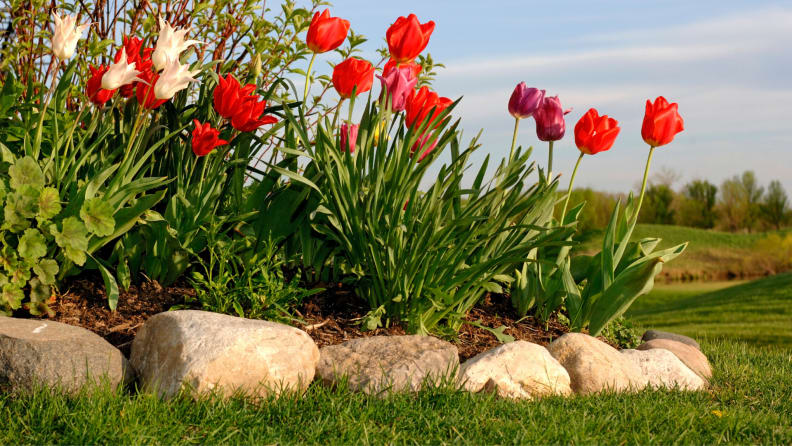
Creating a barrier between your garden and your lawn can make the whole yard look more put together.
Maintaining a lawn edge next to a flower bed, shrubs, or trees is a big time-sucking headache — and you run the risk of decapitating your plants every time you mow nearby. Keep your plants safe and your lawn neat by putting edging between your plants and your lawn.
You can edge your lawn with bricks that are set level with the lawn to give your mower wheels a place to roll while you’re mowing, or use concrete, pavers, stones, wood, steel, or even old wine bottles to make a barrier between your lawn and planting beds.
Adding edging will make your garden look neater and more put-together, like putting a frame around a picture.
- Get the Landecor Edgestone River Rock Edging at The Home Depot for $51
- Get the Nantucket Pavers Concrete Gray Basket Yorkstone Paver at The Home Depot for $6
- Get the Col-met Steel Landscape Edging at Lowe's for $20
4. Get native plants for low-maintenance care
Some plants just aren’t that into you. If they don’t get exactly the right amount of sun, water, or it’s too hot or too cold, or the soil isn’t perfect, they’ll just wilt right in front of you, come down with a plant disease, attract leaf-chewing insects, or suffer hundreds of other problems.
The solution? Get plants that love your yard. Your best bet is to check out a local garden club plant sale, where you can buy plants grown in members’ yards.
Native plants are also a good bet because they’re adapted to local weather and soil. Look at nationwide garden plant finders Lady Bird Johnson Wildflower Center or the National Wildlife Federation, or check out your state’s native plant society, most of which have online plant finders or plant lists.
If you’d like to fill containers with flowers and foliage, plants bred by the Proven Winners company to be especially disease-resistant, but they’ll need more watering and care than a plant you’ve put into the ground.
Get the Proven Winners Lilac Shrub at The Home Depot for $27
5. Consider a lawn alternative
Are you tired of endlessly mowing, watering, and fertilizing your lawn? If you’re a lawn hater, there are several lawn alternatives and ground covers, wildflower beds, mulched beds, and plants that thrive in shade.
Most of these alternatives don’t need the weekly maintenance that lawns force you to do, and they use less water and fertilizer too, saving you money as well as time.
6. With fertilizer, take it slow
If your garden or lawn are looking a little lackluster, it can be lots of fun to spray liquid fertilizer on it and watch it green up fast. The problem with using a water-soluble fertilizer is that it’s easy come, easy go. Fertilizer that dissolves in water also dissolves in rain and washes right out of your yard.
To save time, get a slow-release granular fertilizer that gradually dissolves; popular brands like Osmocote can last the entire growing season. If you want to get your plants happy for the long term, dig in or side-dress your plants with compost, which will add nutrients and organic matter (dead plant parts!) to your soil, making your earthworms happy and your soil more drought-resistant. You can even make your own compost at home.
Before you apply any fertilizer besides compost, check to see what nutrients your soil needs. Most state extension offices will test your soil for pH, nitrogen, potassium, phosphorous, and minerals like calcium and magnesium (and lead) for $10 to $20. Check this list of state extension offices to find out where to get your soil test.
Annual flowers, roses, hydrangeas, and blueberry bushes benefit from a little extra nourishment, but some plants never need fertilizer. It’s easy to over-fertilize plants that are actually yellow because of excess water, disease, or insect damage. Check your plants for common problems before you apply fertilizer, and always check the label to see if your fertilizer is recommended for your plants.
Get the Osmocote Smart-release Plant Food at Amazon for $30
7. Start using mulch
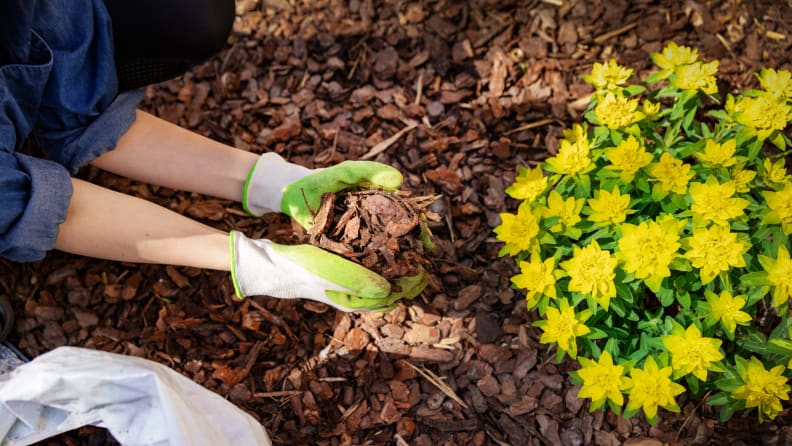
Use mulch to cover up any bare soil spots to keep weeds at bay.
There’s garden product that will reduce how often you have to water your garden, keep the soil cool on hot days, reduce weeds, and improve your soil—and it’s readily available! It’s called mulch. Mulch is a catch-all word for materials to cover your soil, including wood chips, straw, pebbles and ground-up rubber.
To save time in your garden, choose plant-based or “organic” mulches that will build up your soil over time. Avoid wood-chip mulches that come in multiple colors; the dyes used are safe, but that type of mulch is often made of construction and demolition waste wood, and can contain creosote and chromated copper arsenate. If you don’t know much about the manufacturer’s practices, it’s safer to use other plant-based mulches such as shredded pine bark, straw, shredded leaves, grass clippings, or compost.
Apply plant-based mulches 2 to 3 inches thick to shade out weeds and keep water from evaporating out of your soil. Your plants will thank you.
- Get the Mosser Lee Desert Sand Soil Cover at Amazon for $5
- Get the Scotts Combination Mulch at Amazon for $35
8. Plant in containers
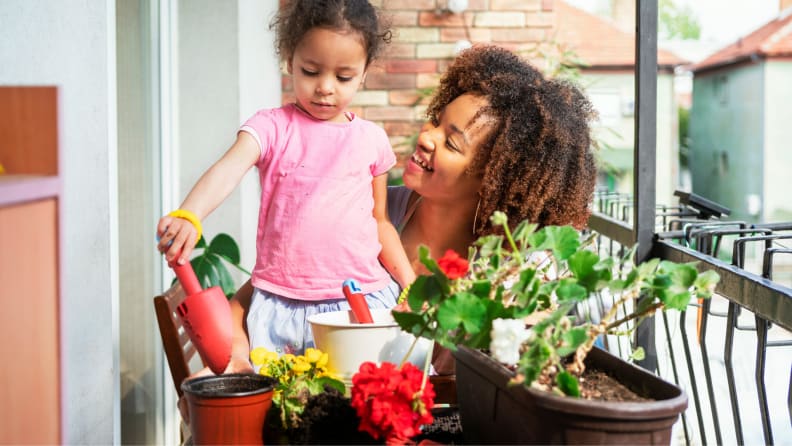
Planting in containers can save time by cutting down on the amount of time needed to fight weeds.
Want to grow [tomatoes(https://reviewed.usatoday.com/cooking/features/10-tomato-recipes), herbs, or flowers, but you don’t want to dig up your lawn? (Or maybe you don’t have a lawn to begin with.) Fill a container with potting mix and plants for an instant garden. Don’t use garden soil; soil drug from your yard tends to get compacted in a pot, so water can’t get to your plants’ roots.
There are many benefits to planting in containers. It’s easier to set up a container than to establish a new garden bed, you’ll spend a lot less time controlling weeds, you can move the container if you find it needs a sunnier spot, and you can put plants with different needs in different pots—Mediterranean herbs like rosemary and thyme prefer drier, sandier soil than basil or parsley.
On the other hand, planting in containers means daily watering for the entire growing season. You may want to invest in a self-watering planter to save yourself even more time.
There are dozens of types of flowers that thrive in containers, and strawberries, tomatoes, peppers, cucumbers, and zucchini do well in containers too. So do many herbs, which have the added bonus of being able to be transported inside and enjoyed all winter.
For an even easier no-fuss garden bed, you can plant flowers directly into a bag of potting soil and put it in your garden. You’ll have to clean up the plastic bag eventually, but it might be worth it.
- Get the Emsco Group Raised Garden Bed at Lowe's for $40
- Get the Miracle Grow Potting Soil at Amazon for $8
- Get the HB Services Self-watering Planter at Amazon for $14
9. Choose perennials
There are two basic types of garden plants: annuals and perennials. Annuals sprout, grow, flower, and die in one season. Common garden annual plants in areas where temps go below freezing in the winter include sunflowers, tomatoes, and basil.
Perennials survive the winter and grow back year after year. Flowers like yarrow, catmint, and goldenrod; herbs like mint, oregano, and sage; and vegetables like rhubarb and asparagus are all perennial in much of the United States.
If you want to save time over the long run, opt for perennials over annuals. They have more time to grow roots over the years, so they’ll withstand dry spells better than shallow-rooted petunias and pansies. Better yet, you can divide perennials every few years, and get new plants without going to a garden center. That alone will save you hours.
10. Weed strategically
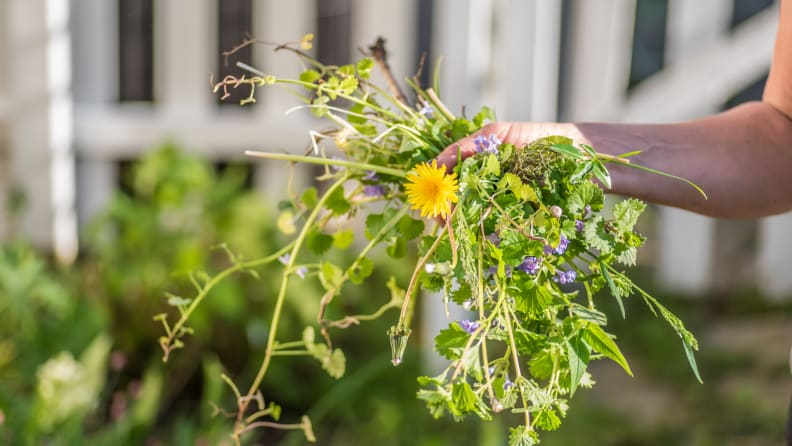
Weed in a strategic way to make sure you don't make more work for yourself down the road.
It’s critical to get rid of weeds in spring months when fast-growing invaders are competing with your young plants for light, space, and water. It isn’t as important in August, when most of your plants are close to their mature size, and it’s too hot to spend much time gardening anyway. Eliminate the April-June weeds, and you’ll minimize the August weeds.
One of the best ways to get rid of spring weeds is to use an old-fashioned garden hoe to slice roots under the soil, or a Japanese hand-hoe if you prefer to get up close and personal. Whatever weeding tool you use, get outside and use it. Sometimes, you’ve got to spend some time to save it.

